Real Madrid Femenino are still a relatively new club, having been founded as Club Deportivo TACON back in 2014, but only known officially as Real Madrid since 2020, following their takeover by the Spanish giants. As a result, their squad doesn’t yet have the same influence in women’s football that the men’s team enjoy in their game.
However, that is not to say that they don’t have quality in the squad, with one player who has really stood out for them being Olga Carmona, the 21-year-old left-sided player who joined the club in 2020 from Sevilla Femenino, and who can feature at full-back, wing-back or as a winger. This scout report will look at how Carmona has become an integral part of Real Madrid’s tactics this season, focusing on how she has fitted into their attack and defence, as well as how she has been a key player in their transitional play, helping to move the ball into the opposing half at speed.
Defence
We will first focus on Olga Carmona’s defensive play, as this is where she has featured in the majority of games this season. However, despite being positionally limited when Real Madrid Femenino are out of possession, she is still able to display her individual qualities, and this section will break down how she does this.
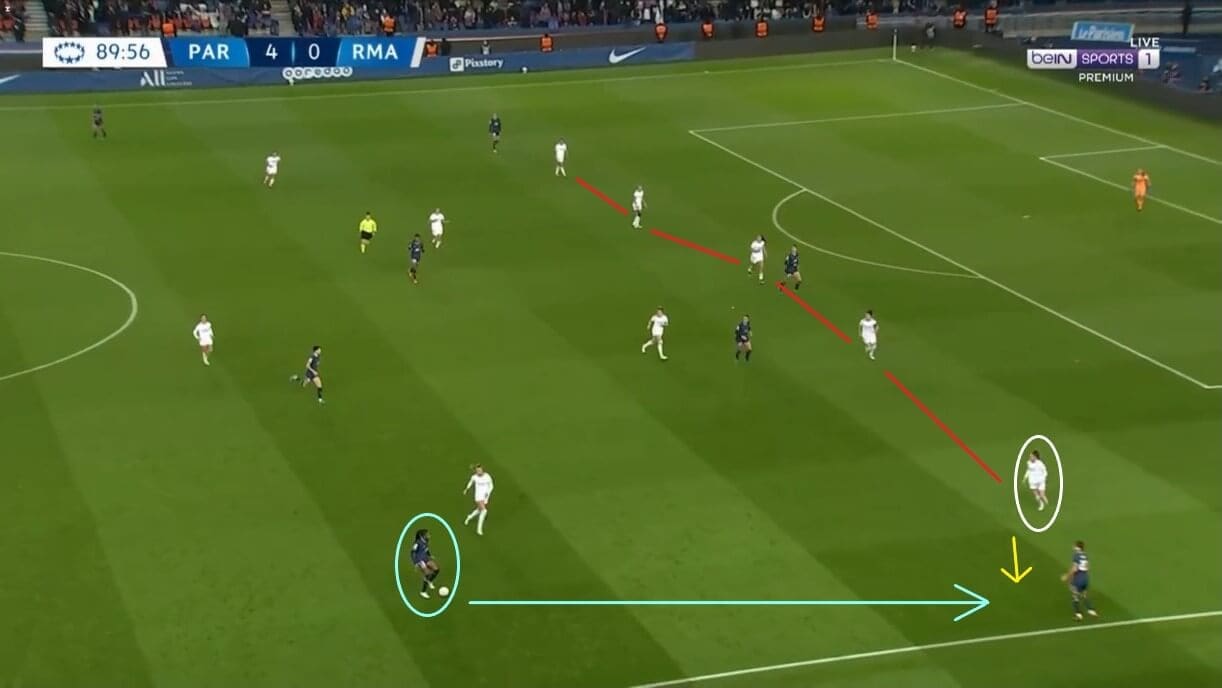
Here, we see Real Madrid with five players in their defensive line. They have been interchangeable in their formations during the current campaign, having used a 4-4-2 setup 27% of the time and a 3-4-1-2 in 20% of their matches, but PSG Feminine’s attacking prowess meant that a five-player defence was the better option in this Champions League group stage clash. Canada right-back Ashley Lawrence, in the blue circle, has taken the ball high up the pitch, and Carmona on most occasions would have come out to close her down. However, she knows that doing that here would open up a route into the space behind, giving PSG an opportunity to run into Real Madrid’s goal area. Therefore, she holds her position and instead works with her defensive teammates to ensure there are no gaps left open.
On the flip side, Lawrence now only has one option with the ball; a pass out to the wing, as indicated by the blue arrow. This makes it easier for Real Madrid to defend against PSG, because they know where the ball will go, and Carmona can time her run to get out to that player once the ball is released, subsequently winning possession and ending the attack. She has made an average of 4.42 interceptions per game this season, and has won 65.9% of her defensive duels, highlighting her defensive capabilities but also her ability to come out and win the ball, which is why she has developed into such a good attacking full-back.
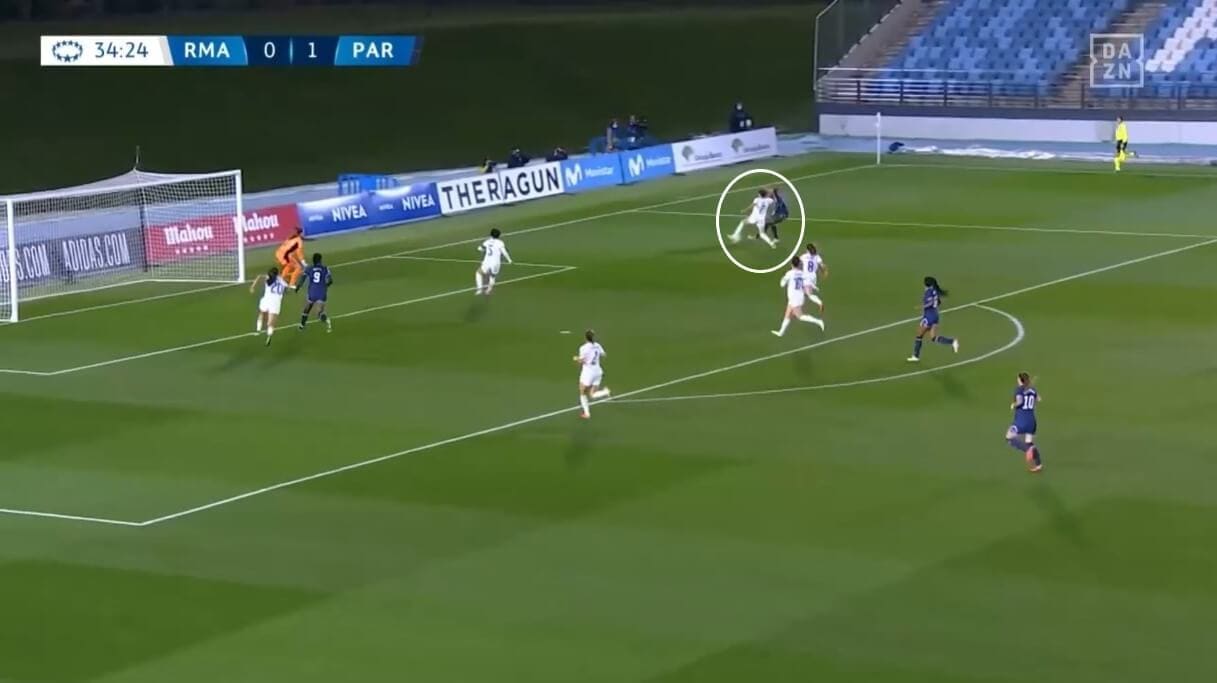
This image shows another example of Carmona getting tight to opponents and blocking a cross into the box. PSG are again trying to find a way through Real Madrid’s defence, this time in the reverse fixture, but this is always difficult when Carmona is on the pitch, as she takes time away from them and forces decisions to be made quicker, leading to more mistakes. Marie-Antoinette Katoto, wearing nine for PSG, was the clear target for the cross here, but Carmona has positioned herself between the in-form France striker and the ball. It is common to see her putting her body in the way of attempted crosses like this, and it reflects her desire to prevent opponents from finding the net, again showing why she has been so reliable for Real Madrid defensively this season.

Carmona also has a natural confidence around the pitch, which is something else that Real Madrid have really benefitted from this season. Here, PSG are trying a different way to get behind the defence, but the Spain international has stepped out of the defensive line to win the ball in the air. This indicates again how she is an attack-minded defender, with a desire to have possession and play an active role in the game, but also her self-discipline, as she steps forward to win the ball, but is still close enough to her defensive teammates so as not to leave them exposed. However, the key thing to admire here is Carmona’s aerial strength, as she has won 34.6% of her duels in the air this season, and it makes opponents think even more carefully about how they attack against Real Madrid.
Transitions
However, whilst having a strong defence has always been essential in football, Real Madrid Femenino’s game is primarily based on their speed during transitions. These situations are where Olga Carmona really comes into her own, as this section of the analysis will show.
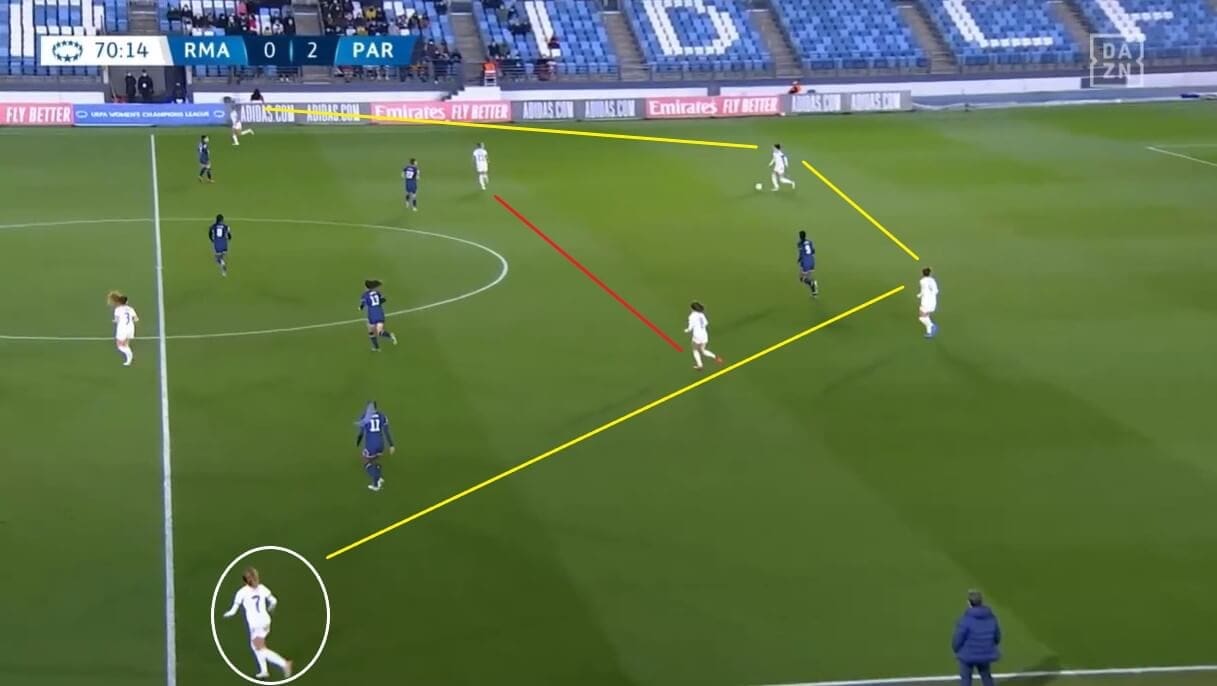
This image shows Real Madrid’s basic defensive structure when in possession at the back. The key thing to note is the positioning of the two full-backs, Carmona and Mexico international Kenti Robles, as both are almost up to the halfway line here. Real Madrid like to get these two players as high up the pitch as possible, creating forward passing options for the defenders to find, and it is often the case that they will run beyond the midfielders, just as they have here (the red line indicates the midfielders’ positions here).
The midfielders’ role in these situations is to draw the opposing players inside the field, giving the full-backs more space to run into, and we can see here how PSG’s key attacking players, including France winger Kadidiatou Diani and Germany midfielder Sara Dabritz have drifted inside the pitch. As mentioned at the beginning of this analysis, Real Madrid like to move the ball around at speed, and Carmona has played a vital role in helping them to do this.
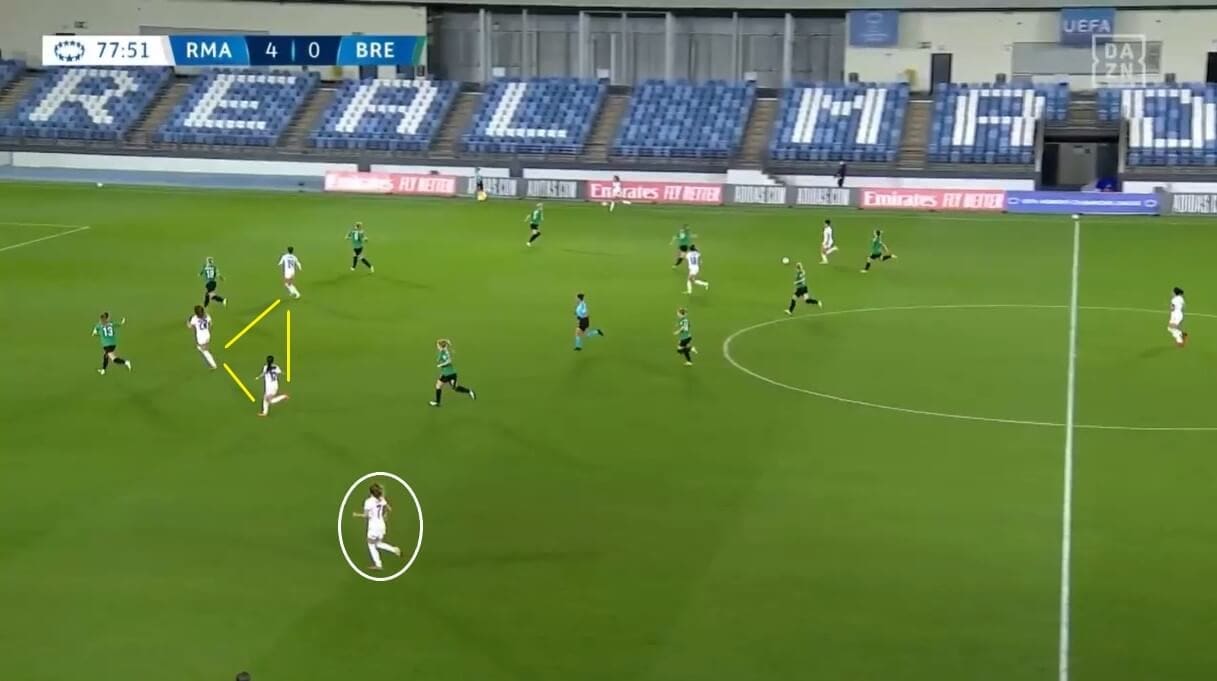
Once up the field, the full-backs are tasked with controlling the wings, and Carmona is often found in the wide spaces as a result, never really cutting inside the pitch. This gives Real Madrid a constant presence in the wide channels, and the defenders have to focus on her and the central attackers simultaneously as a result. Their opponents in this game, Icelandic league champions Breidablik, who are based in Kopavogur, have generally been a tough team to break down, with PSG finding it difficult to score against them in the opening round of the group games.
Real Madrid therefore needed to get more players into the middle to give themselves a better chance of creating goalscoring opportunities, and Carmona’s forward run has allowed them to do that. When the likes of strikers Esther Gonzalez and Athenea del Castillo and attacking midfielder Claudia Zornoza are close together, they give Real Madrid an edge in the final third, and it was clear in this game that that was Real Madrid’s aim. Therefore, again, Carmona is an important player when her team are moving the ball into attacking areas of the pitch.
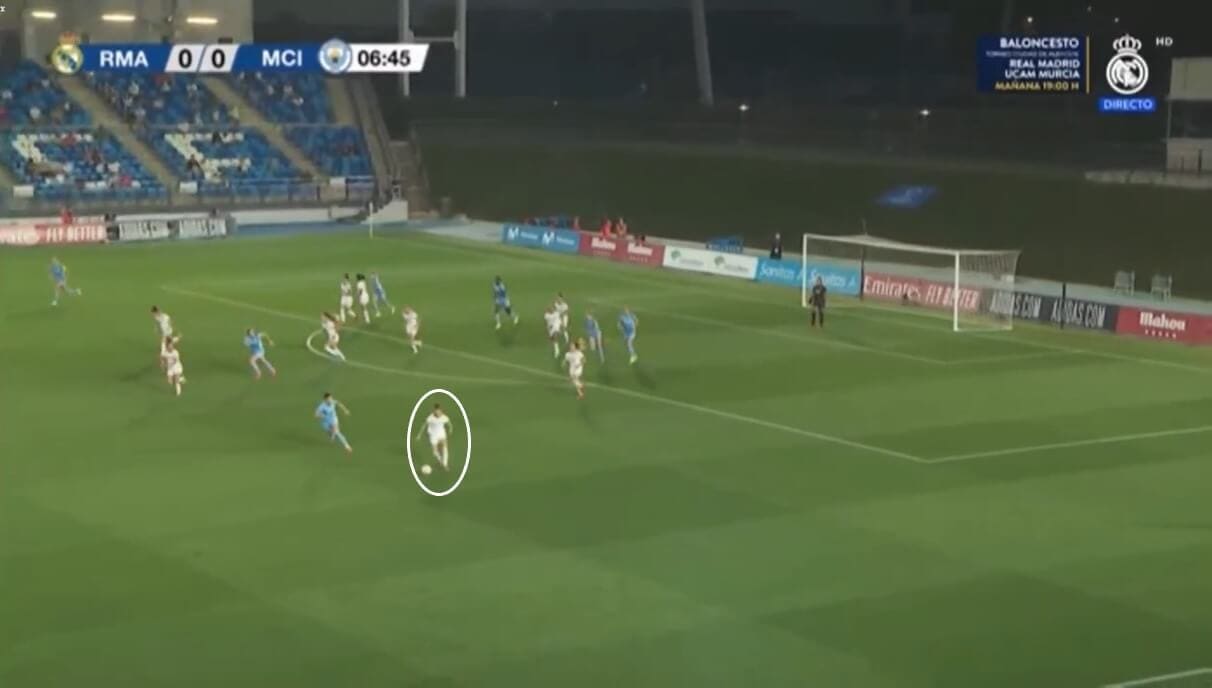
It was notable, however, that Carmona was given a different role against Manchester City Women during the first leg of their Champions League second qualifying round tie. Instead of operating as a wing-back or a full-back, she played as one of the forward line, and this looked to be a tactical decision. We know that Manchester City play with attacking full-backs, asking them to get up the pitch and support the attacks, and this leaves space open in the defensive line that their opponents can exploit.
With Carmona in the forward line, Real Madrid looked to use her pace to expose these gaps at every opportunity, and this was helped by her not needing to drop back and help out in defence. Therefore, again, she is a versatile player and gives Real Madrid tactical options, which is essential in making their counter-attacks successful.
Attack
When in the final third, Olga Carmona plays a key role in helping to break opponents down and create goalscoring opportunities, and this is another reason that she has become such an important player for Real Madrid Femenino this season.
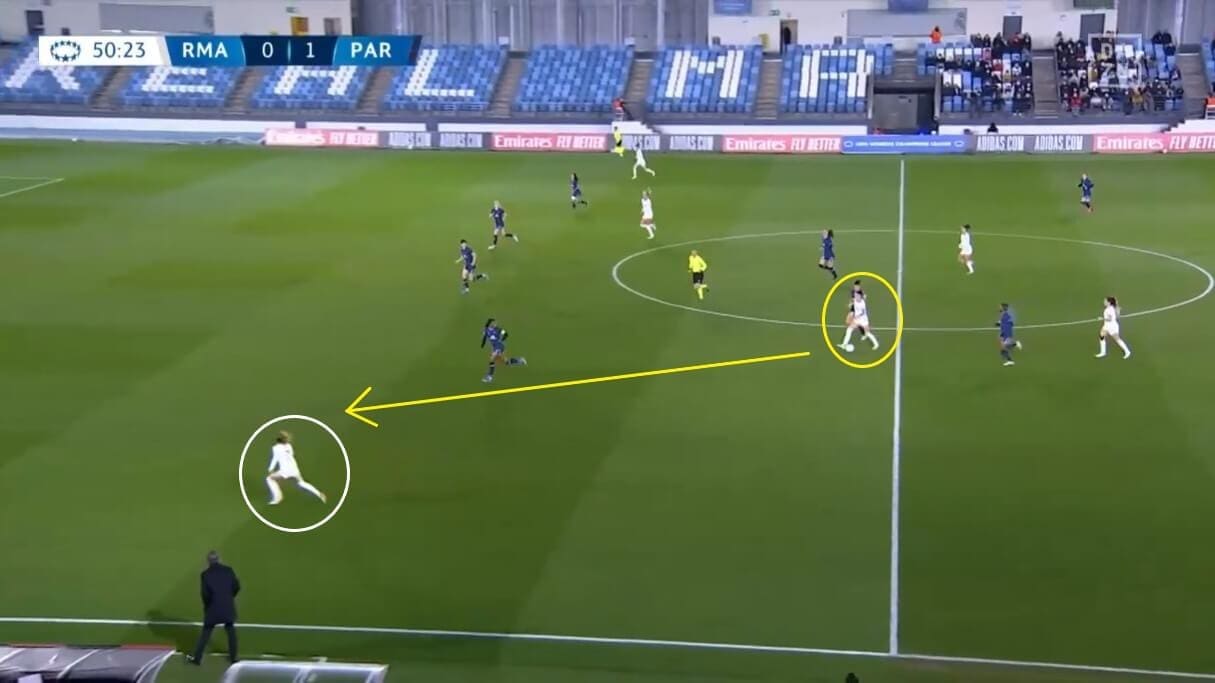
Here, we see Real Madrid with the ball in the middle, looking to find a way around the PSG defence. PSG have come inside the pitch, leaving the wider spaces open, and Carmona has made her way into that area to provide a passing option. Leaving these gaps open was one of PSG’s weaknesses last season, so it is not surprising that Real Madrid have found a way through here.
However, the Spanish side still need to make the opportunity count, which is where Carmona’s positioning becomes critical. By getting ahead of the ball before the pass is made, Real Madrid can keep playing forwards, ensuring the momentum stays with them. It also takes time away from PSG, as, if the ball had been passed sideways, the French side would have been able to move back into defence and close off the gap. Therefore, Carmona’s anticipation and ability to run into these areas early has helped Real Madrid to create plenty of opportunities in the final third.
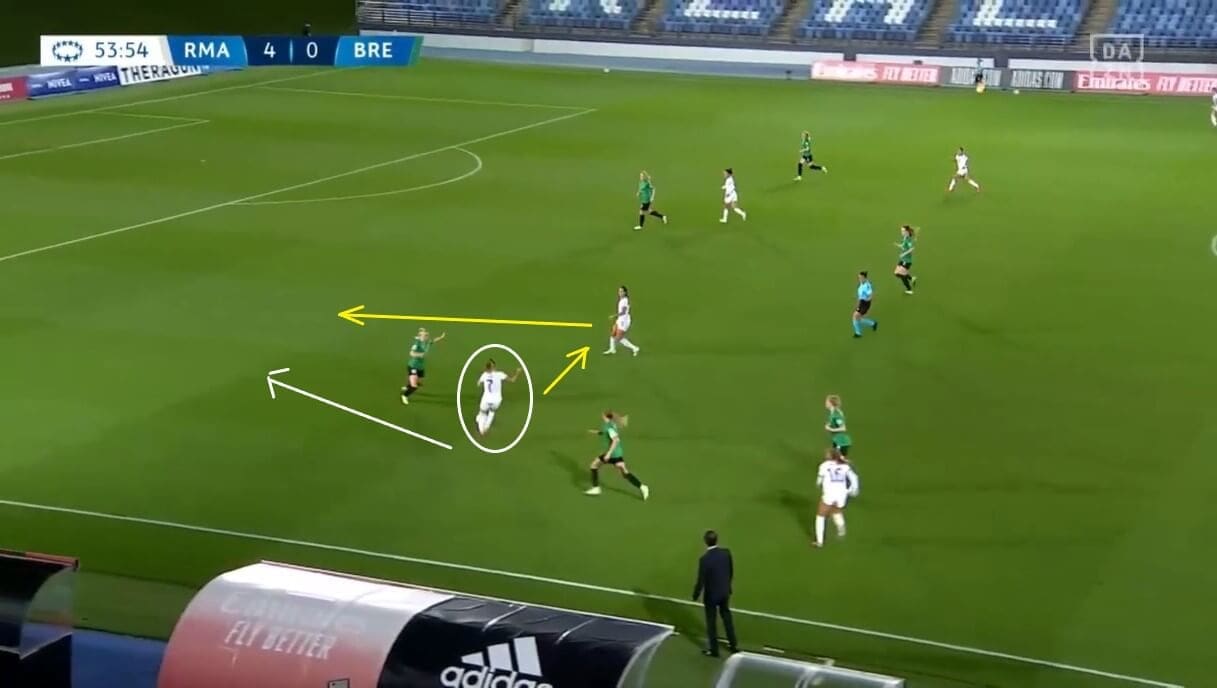
Another key feature of Real Madrid’s attacking tactics is their link-up play. Here, we see how Carmona is looking to pass inside to Lucia Rodriguez, who then makes the one-touch return pass into the space behind the Breidablik player. The yellow arrows indicate the path of the ball, whilst the white arrow marks Carmona’s run behind the defender to meet it in the space behind.
This can happen two or three times in the same attacking move, with quick passes and clever movement something that Real Madrid clearly work on in training, and it benefits them to get players like Carmona into dangerous areas of the pitch, even into the goal area on occasion. However, the fact that she has only scored once this season, and has an expected goals (xG) value per game of 0.13 shows that this is not her main role in the team. However, when she does get into those positions, she gets 33.3% of her shots on target, so asks questions of the opposing goalkeeper when she can.
It also makes it harder for Real Madrid’s opponents to take the ball off them, because, if they look to close the ball down, Real Madrid simply pass around them. Carmona has a good spatial and positional awareness, as well as a passing accuracy of 71.6%, and this again helps her and her teammates to regularly find ways into these areas and cause problems for their opponents.
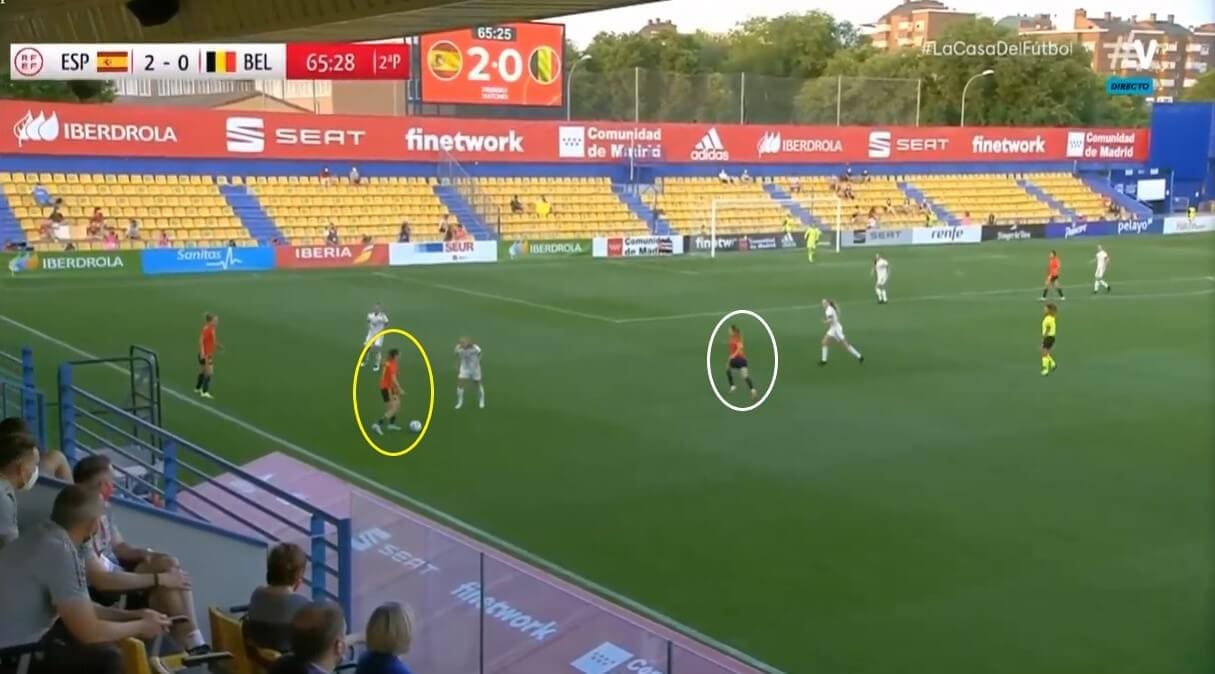
The Spanish national team is primarily made up of Barcelona Femeni players, which is understandable given the obvious quality they have and the success it has brought them. However, this means that there are pre-made partnerships around the team, making it a little more difficult for those from other clubs to have the same impact on the game. Olga Carmona, who made her international debut earlier this year, has had no such problem though, as her individual playing style is similar to Barcelona’s, in that both play with quick ball movement and good positioning to create problems for opponents.
Spain’s style of play sees the wingers and full-backs linking up with each other, creating overloads in the wide channels and making it more difficult for their opponents to defend against them. However, they also like their players to move around the pitch and not remain in the same area, with this image showing Barcelona’s Mariona Caldentey, who has been in fine form in front of goal so far, playing on the outside, whilst Carmona is inside her. This movement increases Spain’s unpredictability, making it harder for Belgium to defend against them, and again highlights Carmona’s versatility, showing how she gives her teams options tactically and increases the threat they pose in the final third.
Conclusion
In conclusion, there is no doubting that Olga Carmona is a star in the making, and will be a huge part of the future of Spanish women’s football, both domestically and internationally. As we have seen throughout this tactical analysis, she plays a key role in defensive and attacking situations for Real Madrid Femenino, and has slotted into their tactics well after her move last year. Real Madrid currently sit second in their Champions League group, behind PSG, and tenth in the Primera Division, so there is plenty of room for them to grow as a club. However, with players like Carmona in the squad, they have a good foundation to build on, so it will be interesting to see how they develop in the coming years.




Comments